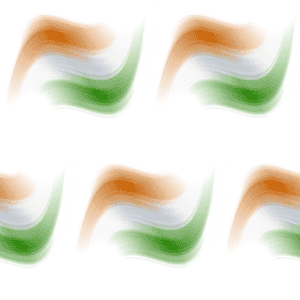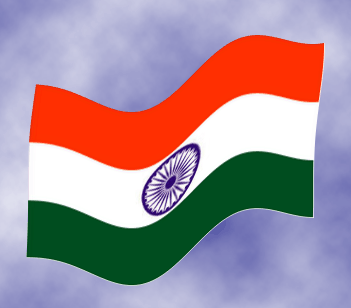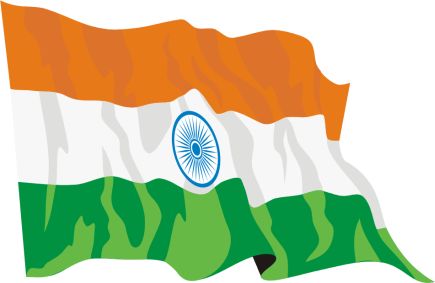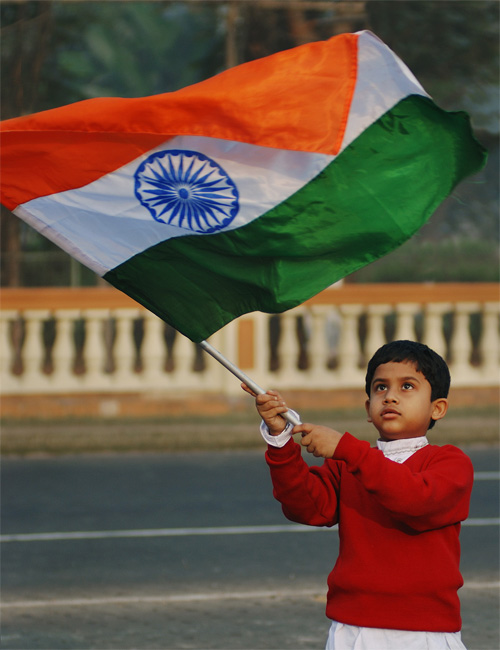
I have studied many international or national flags and banners this last little while and it is especially the national Indian flag that has caught my attention mostly. This beautiful flag can be observed flying from a flagpole and other objects around international institutions, embassies and consulates that is if not in India.

Especially in Europe, many tricolor flags are flown as national or international flags. Belgium, France and Germany fly tricolor type banners, either displaying horizontal or vertical bands. The flag of India is also a tricolor flag displaying the colors green (top), white and saffron, which is a tone of golden yellow.

The Indian flag was first displayed from a flagpole back in 40-s of the 20th century, thus making it a relatively young flag. It was officially adopted by the Constituent Assembly, in the year 1947. Interestingly, the design of the banner is based on and resembles that of the flag that is flown by the Indian National Congress.

It was during that same year (of 1947) that the so called "British Indian Empire" was dissolved. Following this event, the Muslim-majority areas were partitioned to form an individual state, also commonly known as "Pakistan" in our day. During January of 1950, India became a republic and subsequently a new constitution came into effect under which India was established as democratic state.

Mahatma Gandhi first suggested a flag to the Indian National Congress during the third decade of the 20th century. Flag design was produced by Pingali Venkayya. The original design Gandhi was presented with included only two colors; the color red which stood symbolic for the Hindus, and the color green for the Muslims. In the center of the design of the flag a traditional spinning wheel was displayed, representing Gandhi's goal of making the people of India self-reliant by producing their own clothing. The design was altered shortly after to include a white horizontal band in the center for other religious communities, but also to provide a background for the above mentioned spinning wheel. Shortly hereafter, and for the purposes of avoiding sectarian associations with the flag color scheme, saffron, white and green were designated for the three horizontal and equally sized bands.

India, like other countries in the world, maintains a Flag Code. For example, the Indian flag should be flown from a flagpole at half-mast as a manifestation of mourning. The final decision to do so lies with the country's President, who also decides the period of such mourning. When the flag is to be flown from a flag pole at half mast, it must first be raised to the top of the flagpole and then slowly lowered. Only the Indian flag is flown half mast during times of national mourning whereas other regional and national flags remain at normal height.

These tall, beautiful irises are also known as flags because of their long, narrow leaves - like the banners carried by medieval knights. Their intricate multicolored blossoms explain the name iris: in Greek mythology Iris was the goddess of the rainbow and served as a messenger to the gods. Versicolor means "variously colored." The mature long leaves of this plant were collected and dried to be woven into baskets and rush seats and backs for chairs. The iris blossom, sometimes called fleur-de-lis, served as the model for the emblem of French royalty.

What an incredible repertoire of beauty and meaning come together in our native flags! In many northeastern towns and villages there is a Flag Swamp Road, indicating an old region where they grew.

The iris family embraces about fifteen hundred species in almost sixty genera, distributed in temperate and tropical regions, and more than two hundred species native to northern temperate zones. Many gardeners grow colorful iris varieties.

Blue flag is also called water flag, poison flag, and liver lily. In Middle English, the word flagge referred to a rush or reed, and this attractive native wildflower flourishes in marshes and wet meadows as well as in drier meadows. It grows from Labrador to Manitoba; James Bay, Ontario, south to Virginia; and west through Ohio to Wisconsin and Minnesota. The coastal slender blue flag, Iris prismatica, has very narrow, grass-like leaves only a quarter inch wide. A smaller southern blue flag, I. virginica, which rarely reaches two feet tall, grows from Virginia to Florida and west to Texas in wetlands. These irises can grow in ever-enlarging, cosmopolitan groups. White varieties also occur near blue colonies.

Close relatives are the more diminutive blue-eyed grass, Sisyrinchium angustifolium and S. montanum. These ancient American Indian medicinals are widespread across North America. The tall, rugged yellow flag, I. pseudacorus, introduced from Europe, escaped cultivation and also spread widely. It, too, has native medicinal uses.

The tall, sword-like grayish-green leaves of blue flags arise from sturdy, creeping rootstocks. From May to July, these irises flaunt their violet to pale blue blossoms with attractive yellow, green, or white veins and markings on the large recurved petals (sepals). The flowers can be two to four inches wide, sometimes branched, atop sturdy stalks. In late summer the flowers ripen into erect three-lobed green capsules filled with-dark seeds. These woody iris pods mature to dark brown, with shiny interior chambers (exposed when they open), and stand tall through winter snowstorms to mark the thick rhizomes underground. The woody pods are considered "climax flowers," or final flowers, and are often gathered for winter bouquets.

The West Indian or Labor Day Carnival takes place every year in Crown Heights, Brooklyn, New York. The main event of the festivity is the West Indian-American Day Parade that draws about one to three million audiences. Observers watch the carnival on its way through Eastern Parkway. This event is conducted in celebration with American Labor Day which occurs every first Monday of September. The colourful parade is in retrospect to the US flag for the West Indian-American people.

The momentous occasion was founded by Jessie Waddle and her several other West Indian acquaintances in Harlem during the 1920's. They organize costume parties in big covered areas such as Audubon, Savoy and Renaissance Ballrooms because of the chilly weather in the month of February. At this time, pre-Lenten festivities are commemorated in some countries all over the world. But due to the features of Carnival and people have to go on procession in costume, enclosed celebration did not succeed.

The first recognized Carnival parade happened on September 1st 1947 in Harlem. The people who organized the event were the Trinidad Carnival Pageant Committee. Beginning at 110th Street, the course of the parade was along Seventh Avenue.

Dorothy Godfrey was the original Carnival Queen. The Committee was able to raise funds to back the parade. The get-together following the parade was conducted by the Trinidad Carnival Pageant Committee at the Golden Gate Ballroom. It was organized by James M. Green, one more person to help bring about triumph to the first Labor Day Carnival in Harlem.














No comments:
Post a Comment